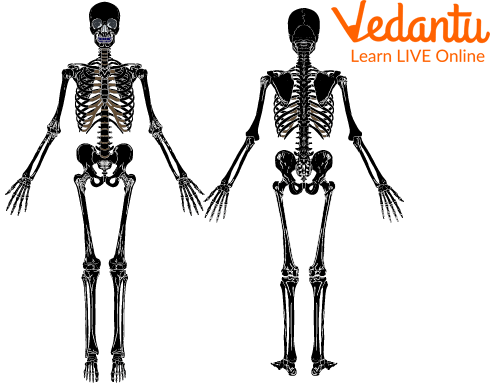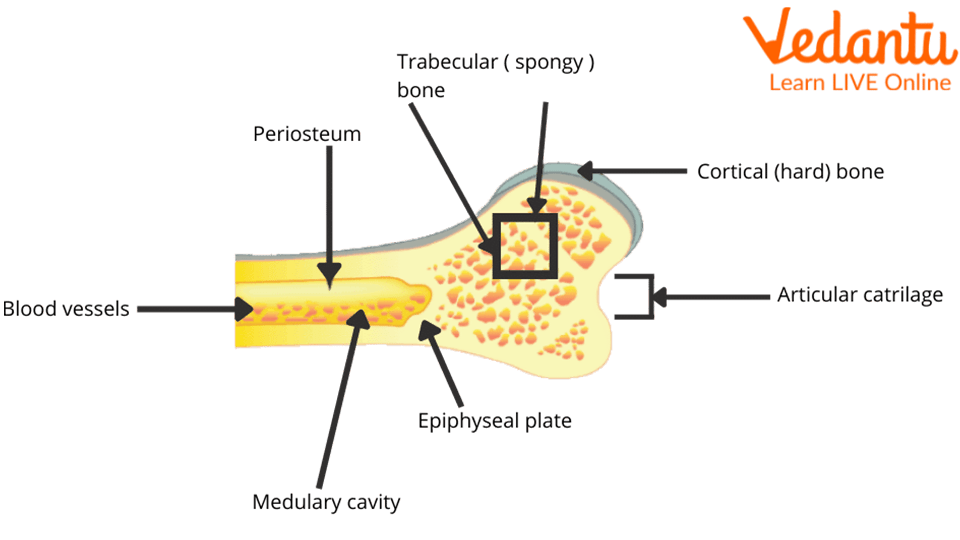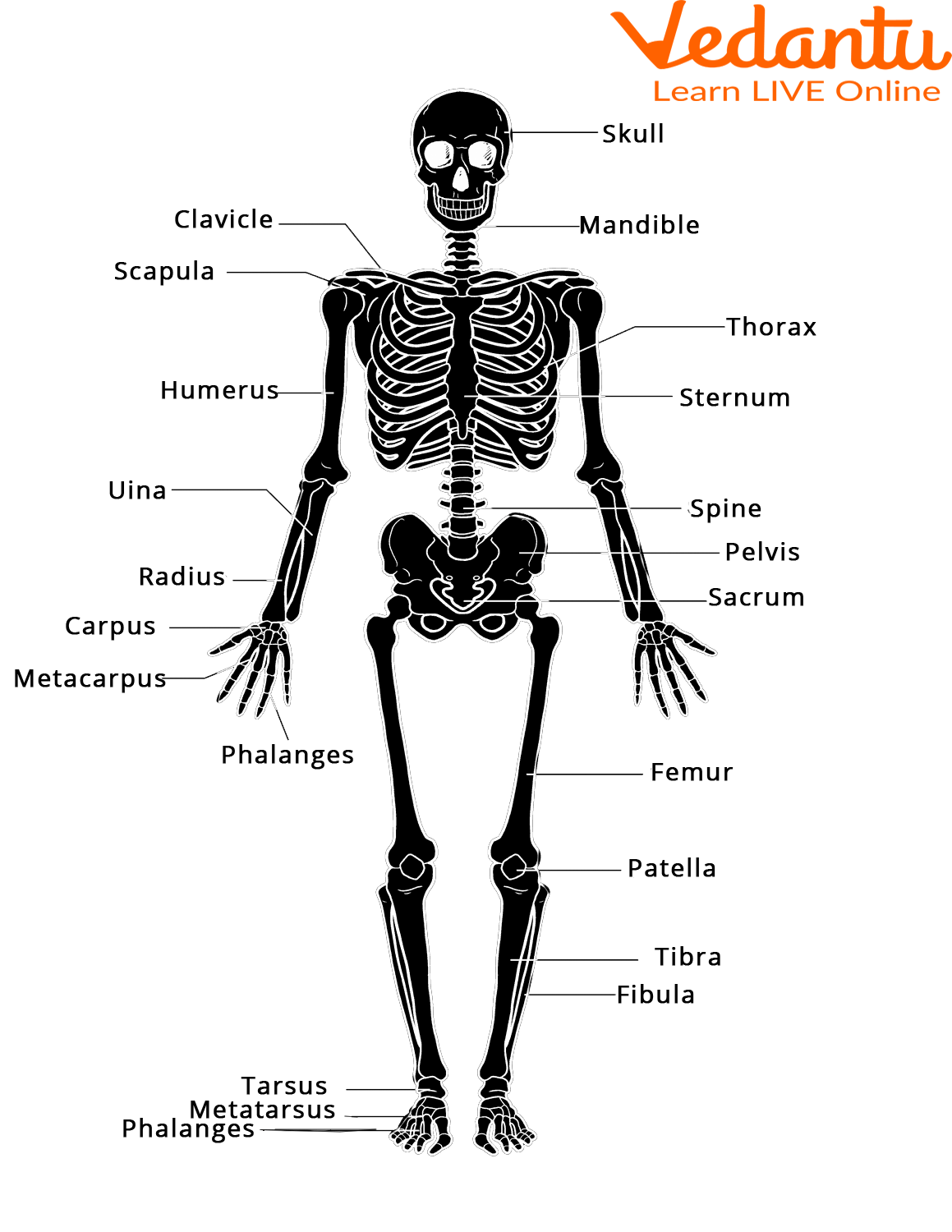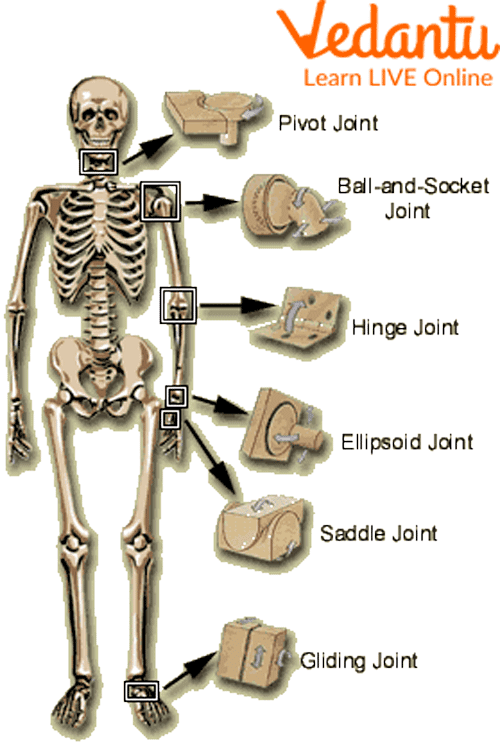




Introduction to the Human Skeletal System
How can humans stand upright? How can we even move? How do we hold any rigidity in our body and are not puddles? That is because of the Skeletal system.
The human body is made up of 206 bones. The total collection of all the bones in a human's body is known as the Skeletal system. Have you ever seen a jellyfish or a worm? Both these animals lack any rigidity in their body, that is due to the absence of a hard skeletal system. The human skeletal system provides rigidity to our bodies alongside strength. It also plays an integral part in movement alongside our muscles.

Human Skeleton
Functions of the Skeletal System
The skeletal system supports the entire body. For example, the spine made up of vertebrae is responsible for holding up and supporting the entire upper body
It is also responsible for movement. Bones are often attached to two or more muscles and they work together to allow the body to move.
Lastly, the skeleton is essential in protecting soft and important organs. The skull protects the brain, the lungs as well as the heart are protected by the ribcage, and the spinal cord is enclosed in the vertebral column of the spine.
What Are Bones Made of?
Our bones are made up of a combination of hard minerals, such as calcium that make up about 70 per cent of the body. It's hard, smooth, and solid. Inside the cortical bone is a previous, spongy bone material called the trabecular or cancellous bone. This way our bones will not break so fluently. At the centre of bones is a softer substance called gist.

The Bone Process
Bone Attribute
Bones are calcified connective tissue present in our body. It forms the maximum portion of the skeleton. Bones are dense, semirigid and porus. It consists of an organic matrix and various mineral components inside them. Bones are tough structures.
Parts of the Skeletal System
Aside from bones, it also consists of cartilage, tendons, ligaments, and joints. Let us discuss these components -
Bones: They are the most basic part of the skeletal system. Bones are made up of a special kind of tissue known as connective tissue which is made stronger with the help of a mineral called calcium. Inside the hard covering of the bone there is a soft sponge part. This part of the bone is lighter and allows for blood vessels to pass through. At the center of the bone lies the Bone Marrow.
Bone marrow is a soft spongy substance mainly responsible for the production of blood cells.

Bones in the Human Body
Ligaments: These are tough elastic bands of tissues that are responsible for attaching one bone to another and keeping them stable
Cartilage: Cartilage refers to a smooth protective covering found over joints. It and synovial fluid allows movement in the joints while protecting the bones from rubbing against one another and wearing down. It is also found between the ribs.
Tendons: Tendons are rope-like structures that join bone to muscle. They also facilitate movement while holding the skeletal system together. They also prevent injury to the muscles by absorbing impact when performing strenuous activities such as jumping.
Joints
Joints refer to the areas within the body where two bones meet or connect. They are essential for movement. Some joints allow for a wide range of motion while others allow more restricted or no movement at all.
Based on the kind of movement they allow, there are three types of joints-
Fibrous Joints- These allow no movement and are also called immovable joints. For example the ones present in the skull.
Cartilaginous Joints- These allow for some movement, and thus are called Partially moveable joints. For example the spine
Synovial Joints- these joints have a wide range of motion and can be subdivided into subcategories based on the kind of movement they allow. These are also called movable joints. For example the shoulder (Ball and socket joints), the knee (Hinge joint), the neck (pivot joint), etc. They are also filled with a liquid known as the synovial fluid which lubricates the joints and makes movement easier and smoother.

Different Types of Movable Joints
How Do Broken Bones Heal?
Bones can heal themselves on their own if they become broken. A broken bone will heal in stages. When it first breaks there will be blood around it and it'll form a kind of scab over the broken portions.
Bringing collagen and cartilage together will allow the gap between the two sides of the break to be bridged. This ground will continue to transfigure and harden until the bone is healed. It can frequently take months for bones to heal back to normal. While the bone is repaired, it cannot take the stress of a normal bone, it cannot bear a heavy weight or more stress.
Functions of Bones
Bones support our bodies and help us to move.
Bones protect our internal organs like the heart, lungs, etc.
Some bones produce our red blood cells, white blood cells, and platelets.
Certain bones store fats present in our body and provide us when we need them.
Bones can also store important minerals for our bodies.
Fun Data about Bones for Kids
Stapes bone which is present in the middle ear is the smallest bone present in our body.
Femur, the thigh bone, is the longest bone in the human body.
Tooth enamel is the hardest substance present in the human body.
Although your bones stop growing when you're around 20, they do constantly rebuild new bone cells.
The chine is made up of 33 bones.
Redbone gist can produce around 5 billion red blood cells each day.
Your bones can become weaker if your body does not have enough calcium. A good reason to drink your milk!
Summary
We have a shape and the power to move because of the skeletal system. As a storehouse of minerals like calcium, it protects and supports the internal organs. The skeletal system of males and females differs slightly. Women, on the other hand, have a wider pelvis and more space in the womb for babies to grow. Males have larger legs and arms, while females have bigger legs and arms.
No matter your age or gender, everyone should exercise and eat healthy to maintain a healthy skeletal system. Always take care of your bones by being kind to them. In this article, we have discussed what are bones made of and what bone attributes are in detail.
FAQs on Human Skeletal System
1. Which are the smallest bones in the skeletal system? Where are they found?
The shape and size of bones vary greatly throughout the human body. Some bones like the vertebrae are small and shaped somewhat like a butterfly, while the radius and ulna bones in the forearm are long and straight. The middle part of the ear consists of three bones - Hammer(malleus), Anvil (incus), and Stirrup (stapes). These are the smallest bones in the human body.
2. What is the difference between cartilage, ligaments, and tendons?
These three are very important parts of the human skeletal system and have very different functions. Cartilage is a smooth protective covering found over joints. It prevents the bones in the joints from rubbing together. Ligaments attach bones to each other. They keep the skeletal structure stable. Tendons join bones to muscles and help in movement.
3. What is the hardest bone to break?
The femur, commonly known as the thigh bone, is the longest and strongest bone in the human body. Because the femur is so sturdy, it usually requires a significant amount of force to fracture or shatter it.
4. How are numerous bones present in the mortal body and what is the total weight of all the bones in the body?
An average grown-up has 206 bones. Some people have a redundant caricature or two and may have further bones in their hands and bases. The total bone weight of an individual is determined by how heavy their entire body is. Bones make up about 15 of a person's total body weight. For illustration, the bones of a person importing 100 pounds would weigh about 15 pounds.
5. What's the bone gist?
In the centre of the bone is a jelly-like matter called bone gist. The bone gist is the heart of the body's blood plant. Not only does bone gist make red blood cells, but it also makes different types of white blood cells.
6. Do bones have skin?
Bones have an external subcaste that's like a thin skin or membrane (mem- brain). This membrane is called the periosteum (per- eye- zilch's- tee- um). During development, the periosteum can become thick and is lined with blood vessels that provide nutrition for the bone.









